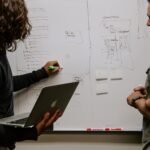Workforce Planning and Forecasting: Preparing for Future Talent Needs
In today’s rapidly changing business landscape, organizations face a constant challenge of aligning their workforce with evolving demands. Workforce planning and forecasting play a pivotal role in ensuring that businesses have the right people with the right skills at the right time. By anticipating future talent needs, companies can proactively address gaps, optimize resource allocation, and drive sustainable growth. In this blog post, we will explore the importance of workforce planning and forecasting and discuss key strategies to effectively manage the process. Understanding Workforce Planning: Workforce planning involves analyzing the current and future workforce requirements of an organization and developing strategies to meet those needs. It goes beyond simply filling vacant positions and encompasses a holistic approach to talent management.
By considering factors such as business goals, market trends, and internal capabilities, organizations can align their workforce strategy with long-term objectives. The Benefits of Workforce Planning and Forecasting: a. Anticipating Skill Gaps: Workforce planning enables businesses to identify skill gaps in their existing workforce and develop strategies to bridge them. By understanding future talent needs, organizations can invest in training and development programs, acquire new talent, or implement succession plans to ensure a seamless transition of critical roles.
Managing Costs: Effective workforce planning helps organizations optimize their human resources budget. By aligning workforce supply and demand, businesses can avoid unnecessary recruitment expenses, reduce turnover costs, and strategically allocate resources to areas that require additional support. c. Enhancing Agility: With workforce planning, organizations can adapt swiftly to changing market conditions and seize new opportunities.
By having a deep understanding of the talent landscape, businesses can quickly mobilize resources, scale teams, or redeploy skills to meet evolving customer demands. Key Strategies for Workforce Planning and Forecasting: a. Data-Driven Approach: Utilize relevant data and analytics to inform workforce planning decisions. Analyze historical trends, conduct skills assessments, and incorporate external factors like industry projections and demographic shifts.
This data-driven approach provides insights into workforce demographics, turnover rates, succession pipelines, and skill requirements. b. Collaboration across Departments: Engage stakeholders from various departments, including HR, finance, and operations, to ensure a comprehensive understanding of workforce needs. By collaborating closely, organizations can align their workforce strategy with overall business objectives and foster a culture of cross-functional teamwork. c. Scenario Planning: Anticipate multiple scenarios based on different business outcomes, such as growth, downsizing, or market fluctuations.
Develop contingency plans to address each scenario, including recruitment strategies, reskilling initiatives, and workforce restructuring if necessary. d. Agile Talent Acquisition: Embrace innovative talent acquisition strategies to attract and retain top talent. Leverage technology, such as applicant tracking systems and AI-powered recruitment tools, to streamline hiring processes, improve candidate assessments, and build a robust talent pipeline. e. Continuous Evaluation and Adaptation: Workforce planning is an ongoing process that requires regular evaluation and adjustment. Monitor the effectiveness of implemented strategies, track key performance indicators, and make necessary changes based on evolving business needs and market dynamics.
Workforce planning and forecasting are critical components of strategic human resource management. By proactively aligning the workforce with business objectives, organizations can optimize talent acquisition, development, and deployment. With a data-driven approach, cross-functional collaboration, and agile strategies, companies can position themselves for success in an ever-changing market. Embracing workforce planning as an integral part of organizational strategy will enable businesses to build a resilient and adaptable workforce capable of meeting future challenges head-on.


































